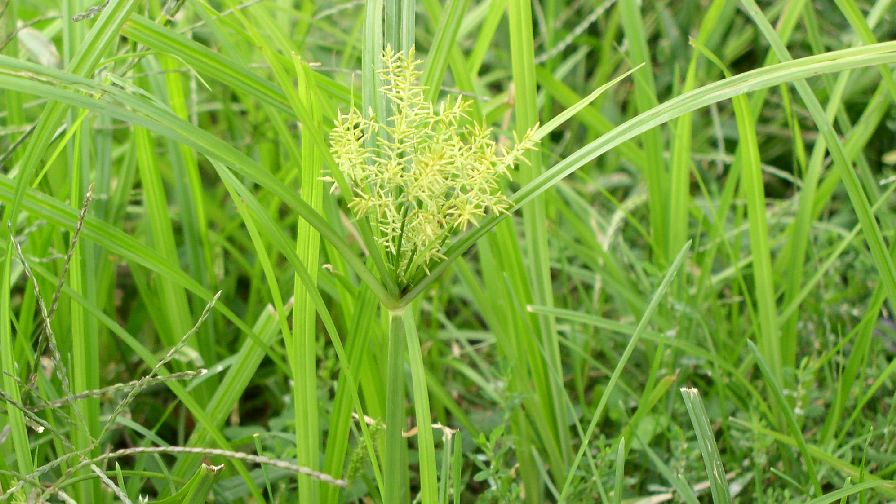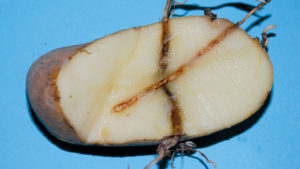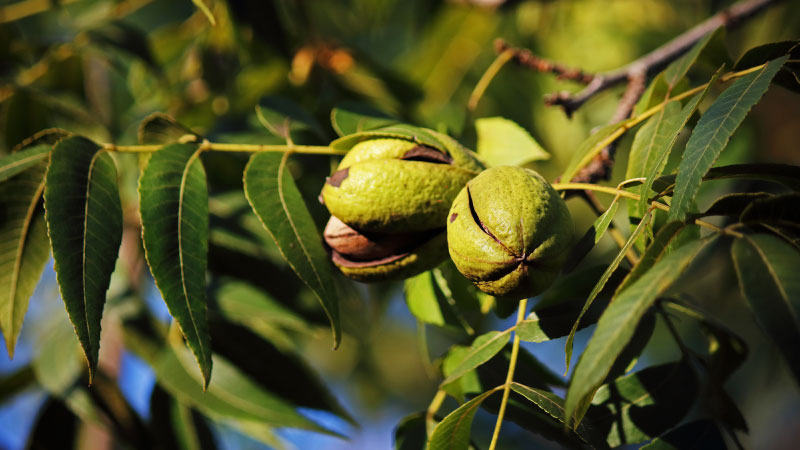Field Scouting Guide: Yellow Nutsedge

This edition of “Field Scouting Guide” concentrates on Cyperus esculentus (aka, Yellow nutsedge). Each month, we will bring you a different pest, ranging from weeds and diseases to insects and even wildlife.
We reached out to several experts to learn how to spot and treat this disease. Our contributors are Bernard H. Zandstra, Michigan State University; Timothy W. Miller, Washington State University; Nathan S. Boyd, Ph.D., University of Florida; Darcy E. P. Telenko, Ph.D., Cornell Cooperative Extension Cornell Vegetable Program; and Joel Felix, Ph.D., Malheur Experiment Station/Oregon State University.
Yellow Nutsedge Basics
- Scientific name: Cyperus esculentus L.
- Crops affected: All cultivated crops
- Geographical range: Worldwide. It favors tropical or temperate regions, but it will extend to cool areas as well. It is widely spread throughout the entire continental U.S. and Hawaii; but it’s not found in South and North Dakota.

Yellow nutsedge rhizomes are capable and do penetrate or grow through potato tubers, reducing quality and marketability.
The Weed’s Impact
Zandstra: Depending on the crop, Yellow nutsedge can reduce production to zero. If uncontrolled, there is total loss of crop. The weed competes with annual crops within two weeks of emergence, and it continues to compete all summer.
Boyd: Nutsedge is a perennial plant, so it is a problem at most growth stages. Obviously, the earlier it emerges, the greater a problem it will be. Overall, the weed’s impact is huge but difficult to quantify. Very little research has tried to quantify the economic impact, but growers across Florida frequently identify nutsedge as one of their key pests. It is one of only two weed species (purple nutsedge is the other) that can puncture the plastic mulch used in plasticulture vegetable production. This causes four distinct problems.
- Problem #1: It weakens the plastic and prevents growers from growing multiple crops on the same bed using the same mulch.
- Problem #2: It can get very thick and make plastic removal at the end of the season very difficult. This adds a lot to labor costs.
- Problem #3: It makes harvests of low growing crops (strawberries, etc.) difficult because it hides the fruit.
- Problem #4: It competes with crops for light and nutrients. Effects on yield vary substantially from crop to crop.
Telenco: Reproduction is primarily by tubers produced at the end of rhizomes (creeping underground stems), but rhizomes can also aid in spread of the weed. Tubers sprout in early May once the soil is warm and can remain dormant in the soil four or more years making it difficult to eliminate from heavily infested areas.
Felix: Marketable onion yields can be reduced by 23% to 84%, with an average yield reduction from yellow nutsedge competition at about 42% per acre. Higher yield reductions and total crop loss have been observed in heavily infested parts of the fields (patches). Yellow nutsedge rhizomes are capable and do penetrate or grow through potato tubers (see photo above), reducing quality and marketability.
Yellow nutsedge emerges in March just before or at the same time with direct seeded onion and sugar beet emergence. The gravity of yellow nutsedge competition is observed in June and July, largely in response to high temperatures, fertilizers and irrigation water.
How to ID the Weed
Growers should keep in mind that yellow nutsedge can be confused with purple nutsedge, as well as annual and perennial grasses. Here are some tricks for distinguishing it from other plants:
Felix: It is important to remember that yellow nutsedge is not a grass or broadleaf weed, it is a sedge. Yellow nutsedge is a perennial and can be identified by its erect, hairless, unbranched triangular stems. Leaves have a shiny yellowish-green appearance with a prominent midrib. It produces a golden seedhead but reproduces primarily by tubers that are borne on rhizomes.
Recommended Treatment
Yellow nutsedge often is treated by soil fumigation. While few selective herbicides are effective, growers do have some chemical and IPM options.
Cultural and IPM Control
- Zandstra: With respect to IPM, do not plant vegetable crops in fields infested with yellow nutsedge, unless you have a long-term plan for management and control. This normally involves rotation to field crops where the few effective treatments can be used.
- Boyd: The only organic option is to switch to TIF (totally impermeable film) mulch as nutsedge does not penetrate it as easily as VIF (virtually impermeable film) or low-density mulches. Management during the fallow period is critical.
Cover crops tend to prevent the formation of new tubers but do not reduce the population. - Telenco: Nutsedge is sensitive to dense shade, therefore control measures like heavy shading crops, close crop spacing, and cultivation before canopy closure can utilize this characteristic. Vegetables with large leaves such as pumpkins and squash can provide enough shade to choke out nutsedge.
- Felix: The most effective way to avoid yellow nutsedge is to plant crops with open canopies (e.g., onion and other vegetables) in non-infested fields.
Practice equipment sanitation so as to avoid movement of tubers from one field to another. Employ effective crop rotations that include corn, because of the prevalence of effective herbicides for that crop.
Equipment sanitation and avoiding introduction of tubers in clean fields are an organic means of controlling the problem.
With respect to IPM, growers should plow and cultivate infested fields last and pressure wash the equipment/implement immediately afterward. Diversified crop rotations that include crops (e.g., corn and dry beans) that have registered herbicides with effectiveness to control yellow nutsedge.
Chemical Treatments:
- Zandstra: In vegetable crops,Dual Magnum, Outlook, Sandea [Halosulfuron, WSSA Group 2] are somewhat effective.
Some ALS inhibitors for field crops also have nutsedge activity. Basagran will burn off the green foliage and is selective in some crops. Roundup applied to flowering plants will reduce stands. Earlier applications are less effective. Rely/Liberty will burn off foliage. - Boyd: The use of halosulfuron, EPTC, or glyphosate during the fallow period combined with cultivation can reduce populations over time. The species spreads very rapidly if not adequately controlled.
- Telenco: Fall tillage and nonselective chemicals can be used once vegetable crops are harvested. Herbicides will not damage tubers in the soil, so a combination of cultivation, and herbicides are needed.
- Felix: Application of s-metolachlor (Dual Magnum, Dual II Magnum, Syngenta) or dimethenamid-p (Outlook, BASF) herbicides prior to crop and weed emergence helps to manage yellow nutsedge in tolerant crops. Application of halosulfuron (Yukon, Sandea, Gowan Co.) containing herbicides or Bentazon (Basagran) after weed and crop emergence helps to control yellow nutsedge in tolerant crops. Always read the label before applying any herbicide on any crop.










